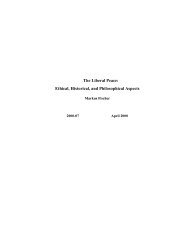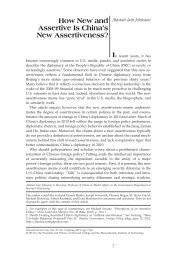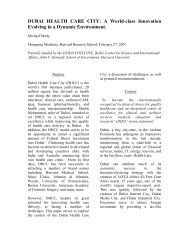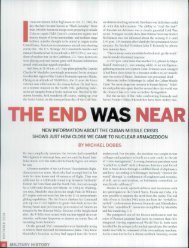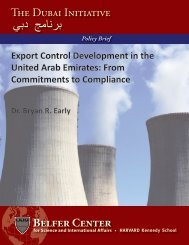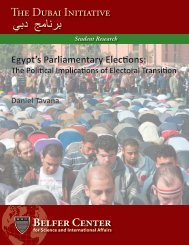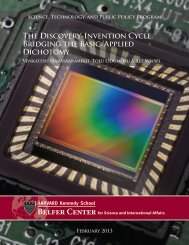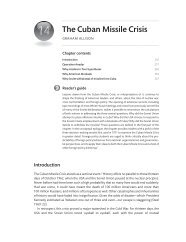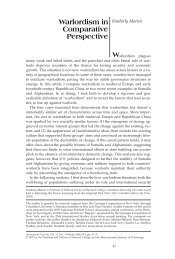The Promise and Problems of Pricing Carbon: - Belfer Center for ...
The Promise and Problems of Pricing Carbon: - Belfer Center for ...
The Promise and Problems of Pricing Carbon: - Belfer Center for ...
You also want an ePaper? Increase the reach of your titles
YUMPU automatically turns print PDFs into web optimized ePapers that Google loves.
THE PROMISE AND PROBLEMS OF PRICING CARBON BELFER CENTER 2011-12<br />
Canadian province <strong>of</strong> Alberta has employed such a tradable carbon per<strong>for</strong>mance st<strong>and</strong>ard <strong>for</strong><br />
most large sources <strong>of</strong> CO2 emissions <strong>and</strong> has required a 12% improvement in the emission<br />
intensity <strong>of</strong> these sources since 2007.<br />
Power plants would be awarded credits <strong>for</strong> generating cleaner (less emission-intensive)<br />
electricity than the st<strong>and</strong>ard. <strong>The</strong>se clean power plants could sell credits to other power plants or<br />
save them <strong>for</strong> future use. Tradable credits promote cost-effectiveness by encouraging the<br />
greatest deployment <strong>of</strong> clean energy from those plants that can lower their emission intensity at<br />
lowest cost. Those power plants could then sell their extra credits to other power plants that face<br />
higher costs <strong>for</strong> deploying clean energy. <strong>The</strong> creation <strong>and</strong> sale <strong>of</strong> clean energy credits would<br />
provide a revenue stream that could conceivably enable the financing <strong>of</strong> low- <strong>and</strong> zero-emission<br />
power plant projects.<br />
Eligible technologies <strong>for</strong> the st<strong>and</strong>ard could extend beyond generation technologies <strong>and</strong><br />
also permit improvements in energy efficiency, or a broad set <strong>of</strong> emission <strong>of</strong>fset activities, to<br />
create tradable credits. Extending the price on carbon to a broader set <strong>of</strong> activities could improve<br />
cost-effectiveness, but allowing <strong>for</strong> energy efficiency <strong>and</strong> other <strong>of</strong>fsets poses risks. As<br />
emphasized above, estimating <strong>of</strong>fsets is complex, requires extensive review <strong>and</strong> monitoring by<br />
third parties or regulatory agencies, <strong>and</strong> risks undermining the objective <strong>of</strong> a policy because <strong>of</strong><br />
the additionality problem.<br />
Monitoring <strong>and</strong> en<strong>for</strong>cement could be relatively straight<strong>for</strong>ward under either a portfolio<br />
or per<strong>for</strong>mance st<strong>and</strong>ard approach. For example, in the United States, electricity generation,<br />
generating technology type, <strong>and</strong> CO2 emissions are already tracked at power plants by state <strong>and</strong><br />
Federal regulators.<br />
A clean energy st<strong>and</strong>ard represents a de facto free allocation <strong>of</strong> the right to emit<br />
greenhouse gases to the power sector. Suppose that the U.S. government created a clean energy<br />
per<strong>for</strong>mance st<strong>and</strong>ard <strong>of</strong> 0.5 tons <strong>of</strong> CO2 per megawatt hour (the 2010 U.S. power sector<br />
emission intensity was 0.56 tons <strong>of</strong> CO2/MWh); this is roughly comparable to a 50% clean<br />
energy st<strong>and</strong>ard that allows all technologies with lower emission intensity than conventional coal<br />
to qualify (with partial crediting <strong>for</strong> low- but non-zero emitting facilities). As a result, a clean<br />
energy st<strong>and</strong>ard could not generate the revenues that a carbon tax or a cap-<strong>and</strong>-trade program<br />
with an allowance auction could.<br />
10




